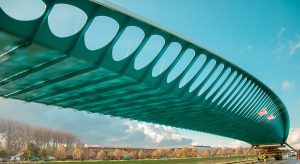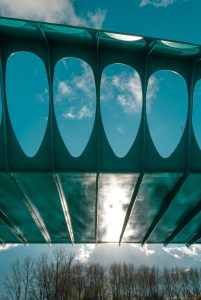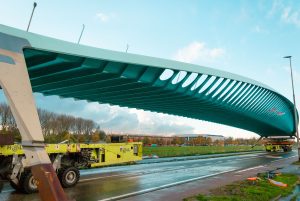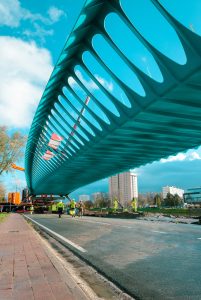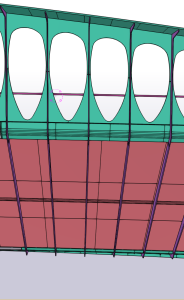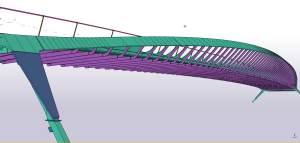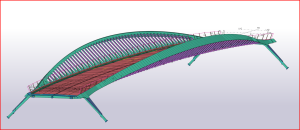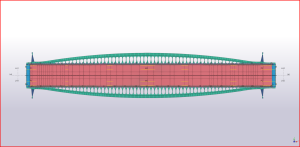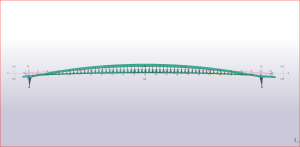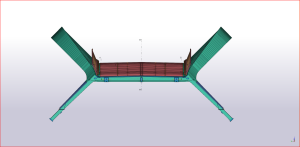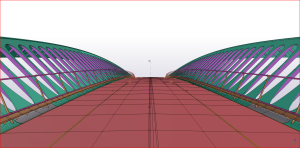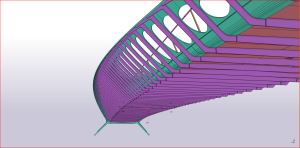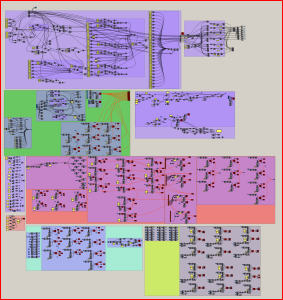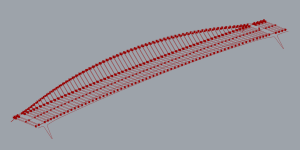Annie Vande Wielebrug
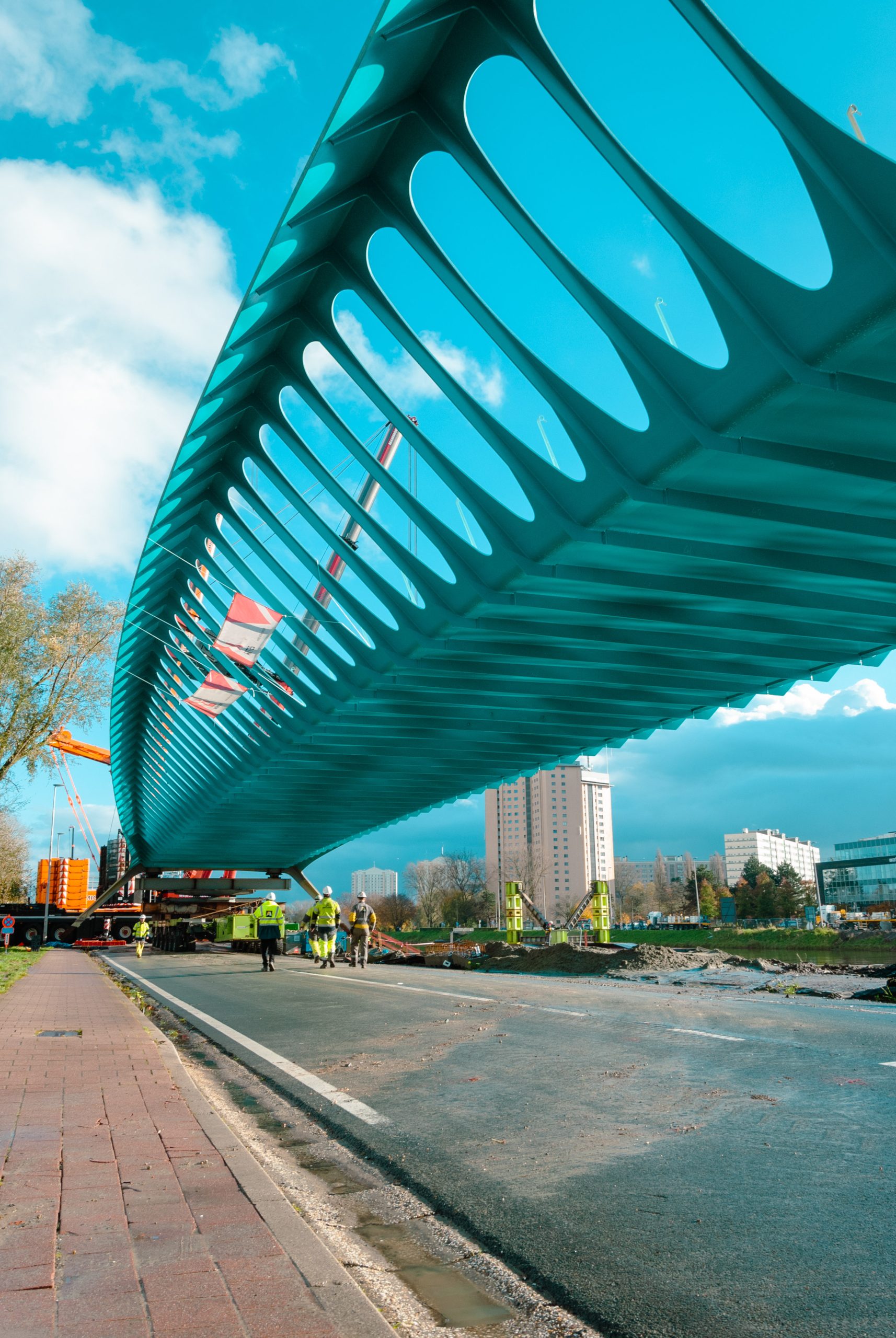
| Kategorie | Infrastrukturprojekte |
|---|---|
| Jahr | 2024 |
| Land | Benelux |
| Organisation | Steeldraft |
| Projektpartner | Aelterman |
| Verfasser | Karel Reygaerts |
| Auftraggeber | Stad Gent |
| Ort des Bauwerkes | Gent Watersportbaan |
| Tags | Parametric designTekla StructuresSteel |
Annie Vande Wielebrug
De Annie Vande Wielebrug over de Watersportbaan te Gent is een brug van 90 meter lang en 15 meter breed. Deze dient als een centrale oversteekplaats voor fietsers en voetgangers en is vernoemd naar de Gentse die als eerste vrouw de wereld rond zeilde.
De brug vormt het sluitstuk van één doorlopende fietsverbinding vanaf de Bloemekenswijk tot aan de Blaarmeersen en het station Gent-Sint-Pieters.
Wat meteen in het oog springt, is het unieke ontwerp van deze brug. Het houdt rekening met het mooie zicht over de Watersportbaan in de richting van de stad.
De zijplaten of flenzen van de stalen draagstructuur zijn niet over de hele lengte even hoog. Ze worden bovendien voorzien van een reeks verticale openingen. Zo krijgt de brug haar optimale structuur, is ze een stuk lichter en ontstaan er panoramische doorzichten vanop de brug.
BIM
De samenwerking met de betrokken partijen verliep vooral via uitwisseling van IFC-modellen.
In deze modellen werd de noodzakelijke geografische en geometrische informatie opgenomen om zo clashchecks uit te voeren en samenwerking te bevorderen tussen alle betrokken partijen.
De opzet van het Tekla-model werd uitgevoerd, via de Tekla Live Link, in Rhino/Grasshopper.
Door het wijzigen van de aanvangs-parameters kon de vorm gestuurd worden (de systeemlijnen).
Aan deze werden alle platen gekoppeld, zowel huidplaten als dwarsschotten. Gezien de dwarsschotten allemaal uniek zijn, bleek dit een zeer handige tool om toe te passen.
Door het gebruik van de project-basispunten in Tekla Structures werd het eenvoudig om opmetingen op de juiste posities in het model te laden ter controle en vanuit Tekla Structures meetpunten en coördinaten te voorzien.
Maakbaarheid
De maakbaarheid of de uitvoering van dit project had z’n eigen unieke uitdagingen. Dit omwille van de glooiende vorm van de brug in zijn totaliteit.
Hiertoe was het heel belangrijk om deze samenbouw op voorhand grondig uit te lichten.
Door nauwe samenwerking met de werkplaats van Aelterman, het gebruik van user-fields en specifieke user-coördinaat-systemen is de brug opgesplitst in verschillen samenbouw-fases. Dit steeds onder hun eigen coördinatensysteem.
Dit zorgde voor meer behapbare tekeningen waarmee de werkplaats aan de slag kon.
Duurzaamheid
De structuur van de brug is open en sober. Alle onderdelen zijn vlot toegankelijk. Zo kan de brug ook makkelijk worden onderhouden en geïnspecteerd.
Annie Vande Wiele Bridge
The Annie Vande Wiele Bridge over the Watersportbaan in Ghent is a bridge that is 90 meters long and 15 meters wide. It serves as a central crossing point for cyclists and pedestrians and is named after the Ghent native who was the first woman to sail around the world.
The bridge is the final piece of a continuous cycling route from the Bloemekenswijk to the Blaarmeersen and Gent-Sint-Pieters station.
What immediately catches the eye is the unique design of this bridge. It takes into account the beautiful view over the Watersportbaan towards the city.
The side plates or flanges of the steel support structure are not of the same height along the entire length. They are also equipped with a series of vertical openings. This gives the bridge its optimal structure, making it lighter and creating panoramic views from the bridge.
BIM
The collaboration with the involved parties mainly proceeded through the exchange of IFC models.
These models contained the necessary geographical and geometrical information to perform clash checks and promote collaboration among all parties involved.
The setup of the Tekla model was executed via the Tekla Live Link in Rhino/Grasshopper.
By changing the initial parameters, the shape could be controlled (the system lines).
All plates, both skin plates and cross-braces, were attached to these. Given that the cross-braces are all unique, this proved to be a very handy tool to apply.
By using project base points in Tekla Structures, it became easy to load measurements at the correct positions in the model for control and to provide measurement points and coordinates from Tekla Structures.
Constructability
The constructability or execution of this project had its own unique challenges due to the undulating shape of the bridge as a whole.
Therefore, it was crucial to thoroughly highlight this assembly in advance.
Through close collaboration with the Aelterman workshop, the use of user fields, and specific user coordinate systems, the bridge was divided into different assembly phases. Each under its own coordinate system.
This resulted in more manageable drawings that the workshop could work with.
Sustainability
The structure of the bridge is open and simple. All parts are easily accessible. This allows the bridge to be easily maintained and inspected.

